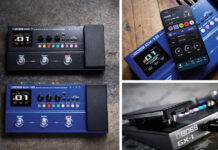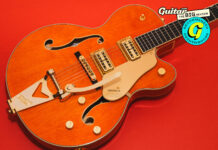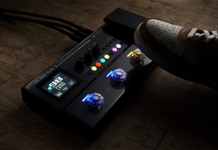
25 ways to upgrade your Gibson Les Paul
Even if you’re disinclined to undertake woodwork or have at it with a soldering iron, there’s still plenty of scope for modifying, customising and upgrading your Les Paul. Broadly speaking, the categories break down into cosmetic changes, electrical modifications, and hardware upgrades.
In the past, many Les Paul players shied away from hardware upgrades because they were reluctant to drill holes in a quality guitar. Nowadays, the range of bridges, tailpieces, tremolos and tuners that will slot right in place is extensive. However, you should be aware that US-made Les Pauls are fitted with hardware that conforms to imperial measurements, whereas those of Far Eastern manufacture – like Epiphones and the various Japanese lawsuit ‘replicas’ – require metric hardware.
The vintage ethos drives many of the electrical modifications, too, with circuit reconfigurations, capacitor tweaks and the ubiquitous PAF replica pickups. However, this is one area where Les Paul players need not be bound by ‘vintage correctness’. There are easy and affordable ways to customise and expand your range of tones, and players are no longer restricted to conventional control layouts or even P-90- and PAF-style pickups.
So here are 25 of our top tips for modifying Les Pauls. Some are very costly while others are cheap, and many won’t cost you a thing.
1. Remove your pickup covers
Covers are usually held in place with two blobs of solder. Use a Stanley knife to cut through the solder, being extremely careful with your fingers and the pickup itself, then lift the cover off. Here we see an ‘uncovered’ double black Shed PAF DaddyThis is one of the earliest mods players performed on their humbucker-equipped Gibsons. It was generally thought at the time that removing the covers made the pickups sound louder. In fact, players who removed their covers were probably just hearing a little more treble, because the capacitive effect of the covers caused high-frequency roll-off. Loose covers can also be a cause of microphonic feedback. Vintage nickel-silver covers were very thin and kept treble loss to a minimum, but later covers – especially thick brass ones – did the upper frequency response no favours.
2. Get a new jack plate
If you wish to buy a metal jack plate, be sure to double-check that the screw holes will line up with those of the original. If in doubt, contact the retailer for more information. Image: TT Zop / WikicommonsEvery guitar design has its weak spots, and the jack plate is the Les Paul’s – because the slim plastic plate is all too easy to snap. The solution is simple: a metal replacement. This is a cheap and reversible modification, but try to ensure the screw holes of the new plate will line up with the old one. If you want to keep the original look, simply install the plastic plate on top of the metal one.
3. The Peter Green mod
If you don’t want to remove the cover from your pickup, you can reverse its polarity electronically. This can be done permanently or it can be linked to a switch to give you the optionDuring his time with Fleetwood Mac, Peter Green’s Les Paul had a very distinctive sound in the middle position. There are two ways you can replicate this. After removing the cover of one pickup (we’d suggest the neck), slacken off the baseplate, slide out the magnet then flip it around (not over) to reverse the magnetic polarity relative to the coil. Tighten the baseplate up, refit your cover if you use one, and you’re done. Alternatively, you can flip the phase electronically by reversing the hot and cold connections.
4. Become a top wrapper
This is one mod you can try easily for zero cost. Bonamassa says it gives the guitar a slinkier feel and makes a set of 11-gauge strings feel more like a 10.5 setIn addition to providing an anchor point for the strings, the stop tailpiece ensures that the strings have a suitable break-angle over the saddles. However, when the tailpiece is screwed tight to the body, the angle might be too sharp, increasing the chances of string breakage. One solution is to feed the strings through the tailpiece from the pickup side and wrap them over the top of the tailpiece. Proponents – among them Joe Bonamassa – claim that you get the tonal benefits of tailpiece-to-body contact coupled with more sustain and a slinkier playing feel, akin to swapping a set of 11s for a set of 10.5s.
5. Try 50s-style wiring
This picture shows the first stage of a 50s-style wiring installation. Note how the ‘bumblebee’ capacitors are connected to the centre tags of the volume controlsIf you own a soldering iron, this is one of the simplest and cheapest mods around. They call it ‘50s wiring’ because it’s the way Gibson hooked things up until around 1962 and the only actual difference was that the company connected the tone control to the output (middle) tag of the volume control rather than the input (outer) tag. This means you can turn down your volume control without the sound muddying up quite so much, and the volume and tone controls also become more interactive.
6. Swap your tailpiece
Fitting an aluminium tailpiece is a cheap and easy modification that improves the tone of a Les Paul for many players. Faber in Germany offers aluminium tailpieces with various degrees of relicingIn the 1950s, Gibson’s stop tailpiece was originally made from aluminium. Later on, this changed to zinc, which remains stock on many current models. Some players claim aluminium gives extra woodiness and more treble with a wider dynamic range, while zinc fans argue that their preferred metal has more low end and sustain. Given that you can get a lightweight aluminium one for around £30, it’s worth doing the Pepsi Challenge.
7. Tone cap swaps and upgrades
0.022uF paper/oil capacitors, nicknamed “bumblebees”, were installed in original Les Pauls. Replicas are available but not all are paper/oil. Russian made K40Y and K42Y paper-oil capacitors are readily available and cost-effective equivalentsIt is incorrect to say that tone capacitors have no effect on the sound of a guitar when the tone controls are fully up, because there is always some treble bleed when a tone circuit is installed, so the value of the capacitor will determine the frequency at which roll-off occurs.
Some players say they can discern sonic differences between different types of capacitor of the same value. The originals were 0.022uF paper/oil types; repros are available or you can use Mallory 150s, Sprague Orange Drops or Vitamin Qs. Some like to experiment with different values too for increased or decreased treble roll-off. Our best advice is to experiment!
8. Install no-load tone pots
Installing no-load potentiometers for your tone controls may help to make your Les Paul sound brighter and clearer. They’re easy to buy, but it’s almost as easy to make them yourselfA lack of clarity and treble is a common Les Paul complaint, but if you don’t want to change your pickups, you can still get some of that treble back when you need it. With any tone control, there’s always some treble bleed through the tone circuit – you can test this and see for yourself by disconnecting the tone circuit from the volume control. So why not try a ‘no load’ tone pot, which will enable you to eliminate the pot from circuit at the twist of a knob, and thus eliminate treble bleed? You can buy them or even make your own, and you’ll notice the biggest difference in the neck position.
9. Lock down your tailpiece
The obvious way to keep the tailpiece fixed in position is to screw it flat to the body. Setting it higher softens the break angle, much like top-wrapping, but the tailpiece may need to be secured. TonePros locking studs provide an effective solutionTraditional tailpiece studs do not grip stop tailpieces at all – the only thing holding the tailpiece in position is the pull of the strings. Often, you’ll see tailpieces tilting forward, and it’s claimed that better tone can be achieved by fixing the tailpiece more securely. TonePros and Faber both offer retrofit means of getting your studs to grip, though the latter’s Tone Lock is the least cosmetically disruptive option.
10. Go nylon
Joe Bonamassa favours nylon saddles for the plain strings on his Gibson signature modelYou might not think that nylon is a classic part of the vintage tone recipe, but 1950s Les Pauls sported nylon nuts. While a vintage-accurate 6/6-grade nylon nut is expensive, you could always try it at the other end. In an effort to minimise rattle and vibrations, Gibson was using nylon saddles on several models by the mid 1960s.
These days, you can easily try swapping out your saddles – it’s an affordable and reversible mod that can have a dramatic effect. Reducing friction is always a good idea if your Les Paul has a Bigsby, while nylon saddles also have a somewhat softer attack and sweeter high end than brass or steel. Some players – Bonamassa included – have been known to try a half rice/half chips approach with metal saddles for the wound strings and nylon for the plain strings. Experiment!
11. Give us a Kluson
The single-line, single-ring Klusons feel smooth and dependableMost original Bursts associated with big-name players have diecast tuners – with the exception of Billy Gibbons’ Pearly Gates. Taking a Black & Decker to the headstock of a vintage LP may seem horrific nowadays, but diecast tuners require wider holes than Klusons and players were more concerned with keeping their guitars in tune than originality. Increased mass at the headstock may have enhanced sustain, too. Nowadays, players are equally likely to retrofit vintage-style tuners, but you’ll need conversion bushes to do it. You’ll get vintage looks and livelier dynamics – and, contrary to vintage lore, decent Kluson-style tuners hold their tuning just as well as diecasts.
12. Get a nut job
Discussions about guitar setup and playability often overlook the importance of a well-cut and properly slotted nut. This may be one for a professional luthier, but you can choose various materials. Here’s one being made by reader Tony Berrington in correct 50s spec nylonMuch is made of the type of material used for nuts. Traditionalists insist on bone, some prefer the slippery attributes of high-tech materials like Graphtech, while Zakk Wylde famously prefers brass. Currently, Gibson installs a variety of nuts depending on the model, including an unusual ‘zero fret’ device that allows player to adjust string height.
Even so, a nut can only affect the tone of open strings, so the main reason for installing a new nut would be if the slots are inaccurately cut or they prove to be too deep after a re-fret. For vintage authenticity, you might consider installing a 6/6 grade nylon nut. Pre-cut nylon nuts are available, but often at a steep price. Alternatively, you can buy a sheet of 6/6 nylon and make one up.
13. Change your pickups
The Seymour Duncan P-Rails has to be the most versatile drop-in pickup replacement for Les Pauls. It combines a P-90 and a narrow single coil with a blade magnet. The coils can be used individually or combined in series for humbucker-type tones. Image: Seymour DuncanDue to the way that they’re mounted, pickup-swapping was never a big thing among Les Paul players; chopping Fenders was always an easier and less scary proposition. These days things are simpler and all kinds of options are now available for humbucker- and P-90-equipped Les Pauls.
If you want an early 50s tone, there are plenty of P-90s in PAF mounts… or what about getting Gretschy with an ‘English mount’ and P-90-sized Filter’Tron or DeArmond soundalikes from TV Jones. Alternatively, Seymour Duncan’s P-Rails gives P-90, PAF and Fender-like sounds at the flick of a switch.
14. Explore using relic plastics
Relic parts like these Dead Mint Club M69 rings don’t come cheap, but they look the part. Image: Dead Mint ClubWithout wishing to offend anybody, getting into replica plastic parts for Les Pauls will lead you straight to the lunatic fringe of the relicing scene. Obsessives often engage in heated discussions about colour, texture and even smell. Put it this way, you will know your bendy butyrate M69 rings are right when they smell of sick and they cost you a mere £200.
Other über-expensive items may include single-ring tuner buttons and genuine Italian celluloid fingerboard inlays. Then there are knobs, switch tips and poker chips to consider. Vintage Haven, Montreux, Dead Mint Club, Monster Relic, Retro Vibe and Time Machine Collection can make your vintage replica look amazing… but it will sound exactly the same.
15. Try Jimmy Page’s wiring
Jimmy Page used a lot of trick wiring with his vintage Les Pauls for out-of-phase and single-coil tones. A definitive schematic has yet to emerge, but here’s one that will effectively do the jobAny Les Paul with two humbuckers is actually equipped with four pickups: two pairs of single-coils with each pair wired in series. When you think about the range of tones you can get from a regular Stratocaster, it’s obvious Les Pauls have a lot of un-tapped potential.
Jimmy Page certainly thought so, and he had four push/pull switches fitted in his 1960 Les Paul. The push/pulls under the volume controls switch between regular humbucker and single-coil tones. The push/pull under the neck tone control is a series/parallel switch, and the one under the bridge tone control switches the pickups in and out of phase for Peter Green-style tones. If your pickups have vintage-style braided wires, they’ll need to be replaced with multicore wires for this mod.
16. Experiment with the no cut out mod
If you would like your volume controls to be completely independent and eliminate the cut out in the middle position, it’s a simple case of reversing the input and output connections on the volume potentiometersThe regular Les Paul wiring scheme means that the controls are somewhat interactive. One of the oddities is the way that turning down one of the volume controls kills both pickups when the pickup selector is in the middle setting.
Some players like it because you can do that stuttering staccato trick where you hit a power chord and ‘play’ it with the switch, but it drives other players bananas. Fortunately, it’s easy to de-couple the volume controls by wiring the volume controls backwards; just follow the diagram. The downside of the mod is more noticeable treble loss when you turn down the volume controls, so treble bleed caps may be required. Try 330pF for starters.
17. Install a Bigsby – without drilling
Filled holes in the tops of vintage Les Pauls are the evidence of long-removed Bigsby vibratos. To some, a Les Paul with a Bigsby looks just as incongruous as a Gretsch without one. Nevertheless, we think Lesters look the nuts with a Bigsby – and you can now install Bigsbys on Les Pauls without drilling any holes at all, thanks to a company called Vibramate.
A specially-designed bracket attaches in place of the stop tailpiece to secure the front of the Bigsby unit, and the strap button screw clamps it at the back. This do-it-yourself installation can be done within minutes, but you’ll need a fresh set of strings, too.
18. Replace the bridge
Trevor Wilkinson’s take on the wrap-over tailpiece is sleek and elegant. It has a movable saddle for the B and G that gives you a much better chance of achieving accurate intonationEarly 50s-style Les Pauls and Les Paul Juniors had wrap over tailpieces, so intonation can be compromised. Fortunately, wrap over replacement bridges with adjustable intonation are readily available. Vintage fans generally prefer ABR-1 style aluminium tune-o-matic bridges with brass saddles to the later all-zinc Nashville bridges.
They can be swapped, but they require thumbwheel posts with a different diameter. Browns Guitars and Faber offer the necessary conversion posts. For replacement wrap over bridges and ABR-1 replicas, try Wilkinson, Pigtail, Badass, Hipshot, Schaller, Gotoh, Tone Pros, Callaham and Gibson too.
19. Add a multi-position switch
The six-way Free Way switch was recently introduced by the UK’s NSF Controls. It means you can add all kinds of options to your guitar without altering its appearance or making the controls too fiddlyInstalling extra switches in Fenders was never a cause for concern, because if you changed your mind, you could always buy a new pickguard to replace the one you had perforated.
Understandably, most Les Paul owners have baulked at the idea of drilling holes in their guitars, so the options for extra pickup configurations have largely been confined to push/pull and push/push switches. So the recent introduction of a six-way toggle switch that fits in place of the regular three-way is an exciting development.
Called the Free-Way Switch, it provides Lester players with countless options. Jimmy Page had one installed in the Les Paul Custom he used for the Ahmet Ertegun tribute concert, and they’re manufactured here in the UK.
20. Experiment with a vibrato
The Stetsbar has long been the option for players who want to mount a proper whammy bar on a Les PaulKey to the initial success of Paul Reed Smith has to be his hybridisation of the Les Paul and the Stratocaster, combining traditional Les Paul tones and vibe with Stratocaster ergonomics and a vintage-style trem that actually stayed in tune. The timing was perfect for a generation grown weary of day-glo Superstrats.
There are now several types of vibrato that can be fitted to Les Pauls without any necessity to drill extra holes or make irreversible alterations. The Schaller ‘Tremolo Les Paul’ is considerably less intrusive than the Floyd Rose FRX, but the market leader seems to be the Stetsbar Stop Tail.
21. Swap pickup magnets
Pickup manufacturers may be reluctant to sell you magnets, but suitable alternatives are available from Stewart-MacDonald and Sensmag Inc. Here’s a rough-cast A4 magnet being slid into position in a Shed PAF DaddyVarious types of magnets are used in pickups, and they all sound different. The most common magnetic alloy is alnico, and P-90s and humbucker pickups usually have alnico II, III, IV or V. Powerful ceramic magnets are also popular with rock players who prefer high output with plenty of brightness.
If you want softer vintage tones, extra brightness or higher output and more aggression, it’s cheaper to swap magnets than swap pickups. Humbuckers have one magnet and P-90s have two, so remove the cover (if necessary), loosen the backplate and slide them out.
22. Adjust the pickup height
Pickup height is a vital ingredient of the fine art of setting up a guitar. Many players don’t realise the huge effect it can often have, and go chasing the latest, hippest pickups without first making the most of the ones they’ve gotHumbuckers have screws at both ends to allow you to adjust the height of the pickups. Similarly, soapbar P-90s have two small screws passing through the covers that do the same job. The proximity of pickup coils to the strings has a massive effect.
Setting the pickups very high can make them sound overly aggressive and midrangey (the magnetic pull may even reduce sustain). When pickups are set lower the tone can be sweeter and more open, but they can sound dull and unresponsive if set too low. To optimise your tone the only tools you need are a screwdriver and your ears. Take time to experiment before buying a new set of pickups.
23. Entrust a professional with a rebuild
Buying a high-end Gibson Les Paul reissue then sending it to Historic Makeovers to have it stripped, dismantled, rebuilt and refinished is not inexpensive, but it’s a lot cheaper than a real 50s Les Paul. Image: Historic MakeoversIt is widely acknowledged that some of Gibson’s current Historic Collection models are the finest guitars they have made since the 1960s, but some owners want even more authenticity. A company called Historic Makeovers offers various ‘packages’ that include nitro refins with aniline dyes, authentic fading, relic’ing, neck reshaping, top re-carving and celluloid inlay replacement.
Optional extras include Brazilian rosewood boards, trussrod replacement, Royalite rebinding, neck re-setting and nylon nut replacement. Prices start from $2,015 and customers supply their own guitars. Converting early-50s Les Pauls to late-50s specs has also become popular of late – the premise being that ‘the tone’ is in the old wood.
24. Try PAF replicas
By and large, replica PAF builders have proved more adept at recreating the look than the tone… but, even so, there are a select few that have managed to nail both. Here’s a real 50s PAF with that iconic decalA desire to recreate the looks and tones of late 1950s models seems to inspire the vast majority of upgrades, and success is largely dependent on the pickups. Unfortunately, PAFs seem to be the hardest pickups to get ‘right’. Certain key ingredients are well understood, and these include plain enamel magnet wire, butyrate bobbins, maple spacers and 2.5-inch magnets.
Leaving the coils unpotted is vital, too, but the real voodoo part involves getting the tension of the winding exactly correct and knowing how much to offset the coils. There are a handful of manufacturers whose PAF replicas are pretty spot-on, but be warned that the truly authentic tone of PAFs doesn’t always conform to expectations.
25. Swap those pots
You can buy control pots from suppliers like Allparts UK, but make sure the shafts are long enough for an archtop Les Paul. Alternatively, check out pre-wired control assemblies from companies like Emerson Custom GuitarsThe value of volume pots does have an effect on the sound of guitars. As a rule of thumb, lower-value pots equate to reduced treble (Fender use 250K pots to sweeten up their single coils). 500K was always the stock value for volume and tone controls in Gibsons, but many Les Pauls are fitted with 300K volume pots and some have 100K tone pots.
If your LP sounds too dull and dark, measure the volume pots and install 500K replacements if 300Ks are fitted. Conversely, 300K pots will help to smooth out over-bright trebles. Some players find the balance they like with a 500K pot for the neck pickup and 300K for the bridge. CTS pots cost around £5, so it’s cheap to experiment.
Check out our essential guides on upgrading your Telecaster, Stratocaster and Gretsch, too.
The post 25 ways to upgrade your Gibson Les Paul appeared first on Guitar.com | All Things Guitar.
Source: www.guitar-bass.net













